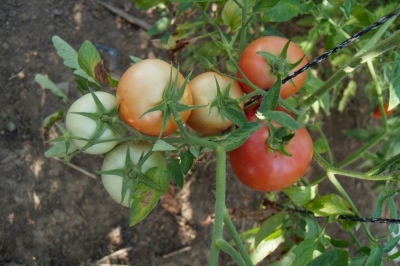
- Category: grade
- Growth type: indeterminate
- Appointment: universal
- Ripening period: mid-early
- Growing conditions: for film greenhouses
- Transportability: Yes
- Bush size: tall
- Bush height, cm: up to 200
- Ripe fruit color: pearl pink
- Fruit shape: round
The tea rose tomato is prized by gardeners for its excellent harvest taste and relatively easy care. The bush of this variety will adorn any site thanks to its bright pink-red fruits and a rather impressive height.
Description of the variety
Tomato Tea Rose is an early ripening variety. The height of the bush reaches 2 m, due to which the yield significantly exceeds that of other varieties, because one plant can thus collect an order of magnitude more fruits. They are formed on brushes in groups of 4-6 pieces. Fruiting occurs consistently and looks like a kind of garland, which looks very decorative.
The main qualities of the fruit
The fruits of the Tea Rose variety are large, of regular rounded shape, bright reddish with a pink tint, of uniform color. Their attractive appearance is very much appreciated by gardeners when preserving for the winter. Fruit weight reaches 400 g. Their peel is thin, but strong, thanks to which the tomato is perfectly stored and tolerates transportation well.
Taste characteristics
The pulp of the tea rose tomato variety is very juicy, fleshy, but at the same time not watery, there are few seeds in it. It tastes sweet, rich tomato flavor. The fruits have a universal purpose - they are good for canning and fresh consumption.
Ripening and fruiting
Tomato Tea rose is classified as a medium-early ripening variety. The first fruits begin to be harvested 90-110 days from the moment of emergence. Fruiting is gradual, lasts up to 2 months.
Yield
Tea rose is a high-yielding tomato variety - up to 6 kg of fruit can be removed from one plant during the fruiting period. From 1 sq. m, with the correct planting scheme for seedlings, it is possible to collect up to 20 kg of fruits.
The timing of planting seedlings and planting in the ground
As a rule, the Tea Rose tomato is planted on seedlings in March, to be planted in a film greenhouse in May. Seedling cultivation lasts no more than 70 days, after this period the stems begin to stretch and outgrow. It is not recommended to plant seedlings in the ground without shelter, since seedlings cannot tolerate exposure to open sunlight and winds.

Growing tomato seedlings is an extremely important process, because it largely depends on whether the gardener will be able to harvest at all. All aspects must be taken into account, from seedbed preparation to planting in the ground.
Landing scheme
For the convenience of caring for seedlings and abundant fruiting, tea rose tomatoes are recommended to be placed according to the scheme 50 by 80, 60 by 60, so that 1 sq. m there were no more than 3 plants.

Growing and care
After planting tea rose seedlings in a permanent place, caring for them does not end. Tomatoes require pinching and tying. If adult bushes are not tied up, then they will creep along the ground, and all the fruits will eventually simply rot on the ground, not having time to ripen.
It is also necessary to form a bush of tomatoes Tea rose so that fruiting is abundant and uniform. You need to pinch all the side shoots, leaving 1-2 main branches, which will be the basis of the stem.
When planting seedlings, you can water it with Kornevin solution for early rooting. And also this drug will help plants to survive the adaptation period in a new place less painfully.
After the seedlings take root and grow, it is advisable to add nitrogen-containing fertilizers, for example, urea, to the soil. Granules are diluted at the rate of 2 tbsp. l. 10 liters of water. Watering rate - 2 liters for one plant. Such dressings must be carried out every 10 days before flowering.
When the Tea Rose tomato begins to gain color, the dressing should be stopped. Watering is done daily. The best way to irrigate is drip. Thus, the water will not stagnate under the plant, irrigation will be uniform, under the root, and not over the foliage.




A plant needs different micronutrients at each stage of growth. All fertilizers can be divided into two groups: mineral and organic. Folk remedies are often used: iodine, yeast, bird droppings, eggshells.
It is important to observe the rate and period of feeding. This also applies to folk remedies and organic fertilizers.
Disease and pest resistance
Tomato Tea Rose belongs to varieties that are resistant to diseases and pests. With the observance of agricultural technology and proper care, the risk of plants being attacked by pests or diseases is minimal. But still, Tea Rose disease is likely to be viral infections that can spread from neighboring plants. To avoid this, it is necessary to weed the site in a timely manner and, if necessary, treat the sick "neighbors" of the Tea Rose with "Fitosporin".


Growing regions
Tomato Tea Rose is suitable for growing in all regions of Russia, only the growing conditions differ. So, in the southern regions and the Volga region, it is possible to grow this variety in unprotected soil. In the middle lane and in the south of the Urals, a film shelter will be optimal. Residents of Siberia, the Far East and northern regions can only afford to grow a Tea Rose in greenhouses.

























































































